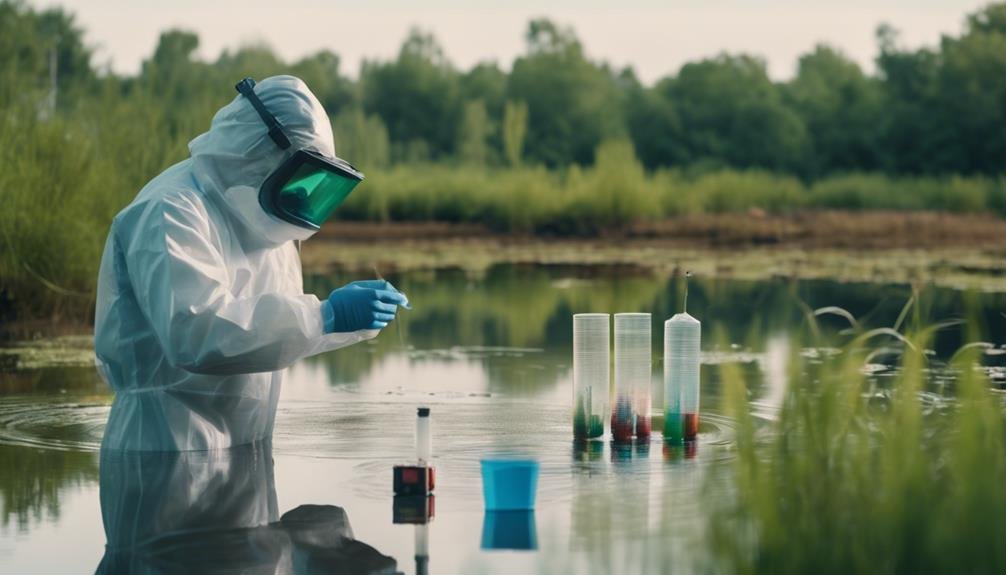Detecting heavy metals in ponds is essential for protecting aquatic ecosystems and human health. Common contaminants like lead, mercury, and cadmium can bioaccumulate in organisms, causing organ damage and impaired growth. Regular monitoring helps assess health risks and maintain water quality. Environmental Impact Assessments evaluate pollution consequences, while regulatory standards set safe concentration limits. Advanced technologies like Atomic Absorption Spectrometry and Inductively Coupled Plasma Mass Spectrometry offer precise detection capabilities. By identifying contamination sources, you can implement targeted remediation strategies. Compliance with guidelines guarantees safety for recreational activities and wildlife habitats. Understanding the importance of heavy metal detection is the first step in preserving pond ecosystems.
Common Heavy Metals in Ponds
While you're likely aware of the importance of pond ecosystems, you may not realize that they're often home to several common heavy metals, including lead, mercury, cadmium, arsenic, and copper. These heavy metals can enter ponds through various sources, such as agricultural runoff, industrial discharges, and atmospheric deposition.
It's important to understand that certain heavy metals can have significant impacts on aquatic life and overall ecosystem health. Heavy metal pollution in ponds can lead to serious consequences for both wildlife and human health. These metals can accumulate in water, sediment, and aquatic organisms, potentially entering the food chain.
This bioaccumulation can result in toxicity and long-term health issues for fish, plants, and other pond inhabitants. Additionally, if contaminated water is used for irrigation or as a source of drinking water, it may pose risks to human health. Regular monitoring and testing of heavy metal concentrations in ponds are vital to maintain water quality and prevent potential harm.
Health Risks to Aquatic Life
In ponds contaminated with heavy metals, aquatic life faces a multitude of serious health risks that can devastate entire ecosystems. Heavy metal contamination in aquatic environments leads to bioaccumulation, where these toxic substances build up in organisms over time. This accumulation can have severe consequences for the health and survival of aquatic species.
This can greatly impact their ability to maintain healthy populations. Chronic exposure to these contaminants can result in organ damage, impaired growth, and weakened immune responses, making organisms more susceptible to diseases.
You'll find that pollution in aquatic ecosystems disrupts the delicate balance of life in ponds. Fish and other aquatic organisms exposed to elevated levels of heavy metals like mercury and lead often experience reproductive system problems.
Moreover, heavy metal contamination can alter the behavior and physiology of aquatic species, affecting overall population dynamics.
To safeguard these ecosystems, it's essential to regularly monitor levels of heavy metals in ponds. By understanding the extent of contamination, you can better assess the health risks to aquatic life and take appropriate measures to mitigate potential threats to biodiversity.
Environmental Impact Assessment Methods

You'll find that Environmental Impact Assessment methods are essential tools for evaluating the consequences of heavy metal pollution in pond ecosystems. These methods help you understand the complex interactions between contaminants and the environment, focusing on key factors like water quality, biodiversity, and ecosystem health.
When evaluating heavy metal contamination in pond ecosystems, you'll need to monitor various parameters regularly. This includes measuring the concentration of heavy metals in water, sediment, and aquatic organisms. By tracking these levels over time, you can identify trends and potential sources of environmental damage.
Environmental Impact Assessments provide valuable insights into the ecological consequences of heavy metal exposure. They help you determine how pollution affects different species and the overall health of the pond ecosystem. This information is essential for developing effective remediation strategies to protect aquatic life.
Regulatory Standards and Guidelines
Regulatory standards and guidelines form the backbone of heavy metal management in pond ecosystems, providing essential benchmarks for monitoring and controlling contamination levels. You'll find that these standards set specific limits for heavy metal concentrations in ponds to safeguard both aquatic life and human health. Organizations like the EPA offer detailed guidelines that you can follow to assess and maintain water quality in these bodies of water.
When you're dealing with pond management, it's important to understand that compliance with these regulatory standards guarantees the safety of the water for recreational activities and wildlife habitat. By adhering to these guidelines, you're helping to prevent bioaccumulation and biomagnification of heavy metals in the pond ecosystem. This is particularly significant because these processes can have far-reaching effects on the entire food chain.
To maintain water quality and ecosystem balance, you'll need to implement regular testing and monitoring programs. These efforts are crucial for detecting any changes in heavy metal levels and taking prompt action when necessary.
Advanced Detection Technologies

Two cutting-edge technologies, Atomic Absorption Spectrometry (AA) and Inductively Coupled Plasma Mass Spectrometry (ICP-MS), have revolutionized the detection of heavy metals in ponds with their high precision and ability to measure trace levels of contaminants. These advanced methods allow you to detect heavy metals like Cd, lead, and arsenic at concentrations exceeding regulatory limits. In recent years, these technologies have become essential for monitoring metal pollution in aquatic systems.
Speciation analysis techniques complement these methods, helping you differentiate between various forms of metal contaminants. This information is vital for evaluating the toxicity and potential impact on aquatic ecosystems. By utilizing these advanced detection technologies, you can effectively identify sources of contamination and implement targeted remediation strategies.
Here's a comparison of AA and ICP-MS for metals analysis in pond water:
| Feature | AA | ICP-MS | Speciation Analysis |
|---|---|---|---|
| Sensitivity | High | Very High | Moderate |
| Multi-element | Limited | Excellent | Varies |
| Sample prep | Simple | Complex | Complex |
| Cost | Moderate | High | High |
| Speed | Moderate | Fast | Slow |
Understanding these technologies' capabilities enables you to make informed decisions when monitoring heavy metals in ponds, ensuring the protection of aquatic life and human health from contaminated water.
Frequently Asked Questions
Why Is It Important to Detect Heavy Metals?
You'll want to detect heavy metals because they're toxic and can harm your health. They accumulate in living organisms and the environment. Identifying them helps prevent risks and allows for timely interventions to protect ecosystems and people.
Why Is It Important to Measure the Concentration of Heavy Metals in Fish?
Oh, you're just dying to know about fish and metals, aren't you? Well, measuring heavy metal concentrations in fish helps you avoid poisoning yourself, protects aquatic ecosystems, and makes sure you're not unknowingly contributing to environmental contamination through your seafood choices.
Why Do We Test for Metals in Water?
You test for metals in water to protect your health and the environment. It helps you identify contamination sources, guarantee regulatory compliance, and prevent harmful exposure. You're safeguarding ecosystems and preventing bioaccumulation in aquatic food chains.
How Do Heavy Metals Affect the Aquatic Environment?
Heavy metals can wreak havoc on your pond's ecosystem. They'll accumulate in organisms, disrupt their health, and cause toxic effects. You'll see reduced biodiversity, ecosystem imbalances, and potential harm to plants and invertebrates as they spread through the food chain.
Conclusion
You've learned about the critical importance of detecting heavy metals in ponds. But why should you care?
These contaminants pose serious risks to aquatic life and the environment. By understanding detection methods, regulatory standards, and advanced technologies, you're better equipped to safeguard these ecosystems.
Remember, pond health impacts the broader environment. Stay informed, follow guidelines, and utilize modern detection techniques to guarantee your local ponds remain safe and thriving habitats for years to come.

